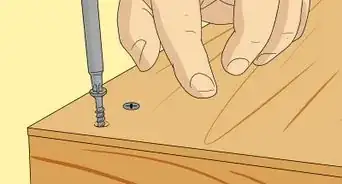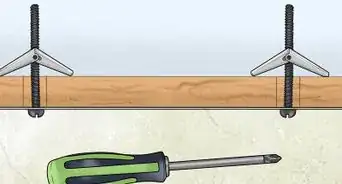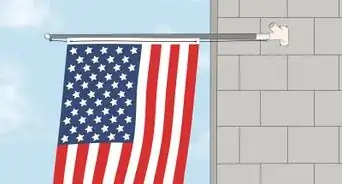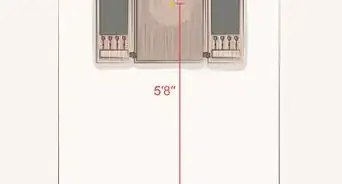wikiHow is a “wiki,” similar to Wikipedia, which means that many of our articles are co-written by multiple authors. To create this article, 37 people, some anonymous, worked to edit and improve it over time.
This article has been viewed 418,929 times.
Learn more...
Many Americans proudly choose to display the U.S. flag, often during National Flag Week leading up to Flag Day on June 14 and around Independence Day on the 4th of July. Whether you fly the colors 24/7 or merely during special occasions, it's important to ensure that the flag is displayed with the dignity and respect it deserves. Luckily, there are extensive guidelines (detailed in the U.S. Flag Code) for displaying the American flag properly, whether it's flown by itself or alongside other flags. Read on for detailed instructions.
Steps
Flying the American Flag
-
1Keep the flag visible. Traditionally, the flag was displayed in public only from sunrise to sunset. However, the flag may be displayed at all times if it's illuminated during darkness. If you're not flying the flag on a traditional flagpole, your precise concerns may vary - when in doubt, simply ensure that the entire flag is visible and that it is free to billow without obstruction.[1]
- When displayed from a staff projecting from a building, the union (the starred blue canton) should be placed at the peak of the staff unless the flag is at half staff. When suspended from a rope extending from the building on a pole, the flag should be hoisted out, union first from the building.
- When the U.S. flag is displayed other than from a staff, it should be displayed flat, so that its folds fall free. When displayed over a street, place the union so it faces north or east, depending upon the direction of the street.
- When flying the flag from a vehicle, attach it to the antenna or clamp the flagstaff to the right fender (or window).
-
2Only fly the flag during suitable weather. Generally, it's discouraged to display the flag during inclement weather like rain, snow and wind storms. However, it is acceptable to fly special-designated "all-weather" flags during rough weather.[2] Your primary goal should be to avoid aging or wearing the flag more quickly than is necessary - knowingly subjecting a flag to conditions that will damage it is disrespectful. The more durable your flag's construction, the wider range of weather conditions it is suited for.Advertisement
-
3Raise and lower the flag respectfully. The U.S. flag code states that the flag should be "hoisted briskly and lowered ceremoniously." In everyday English, this means that you should raise the flag quickly (without rushing) and lower the flag slowly (without dawdling.) The flag is raised quickly so as to give the impression that the flag is eager to get to the top of the pole and represent the nation. It's lowered slowly to give the impression that it's reluctant to leave its post.[3]
- The flag, when flown at half staff, has a special procedure for its raising and lowering. When being raised, the flag should be first hoisted to the peak for a moment and then lowered to half staff position. The flag should be again raised to the peak before it is lowered for the day.
-
4Arrange the flag appropriately in relation to other flags. When flags of two or more nations are displayed, they must be flown from separate staffs of the same height. The flags should be of approximately equal size. International usage forbids the display of the flag of one nation above that of another nation in time of peace. But when the U.S. flag is displayed with other flags (states, localities or pennants of societies), the following conventions apply:[4]
- When displayed with another flag against a wall from crossed staffs, the U.S. flag should be on its own right (so that when you look at the flags, you see the U.S. flag on the left), and the U.S. flag's staff should be in front of the staff of the other flag.
- Place the U.S. flag at the center and at the highest point of the group when a number of flags of states, localities or pennants of societies are grouped and displayed from staffs.
- When other flags are flown from the same halyard, the U.S. flag should always be at the peak. Other flags are flown below in this order: POW/MIA flag, other nation's flag, state flag, then civil flags of companies, schools, etc.
- When other flags are flown from adjacent staffs, the U.S. flag should be hoisted first and lowered last. No flag may fly above or to the right (which is typically the audience's left) of the U.S. flag.
-
5Give the flag a prominent position. The flag should be given a position of importance, even if it's not the primary center of attention at a given event. Though flag-flying accommodations will vary based on the location of the event, try to avoid displaying the flag in such a way that it appears to be an afterthought. For instance, if you're hosting a charity dinner for Veteran's Day, it's much more respectful to display the flag prominently from a pole in the front yard than to pin it over a doorway or window. The Flag Code dictates a wide range of rules for respectfully displaying the flag during special occasions or ceremonies:[5]
- The U.S. flag should be displayed prominently at the ceremony of unveiling a statue or monument, but should never be used as the covering for the statue or monument.
- When the flag is displayed from a staff in a church or public auditorium, it should hold the position of superior prominence, in advance of the audience, and in the position of honor at the clergy's or speaker's right facing the audience, next to the church flag. Any other flag so displayed should be placed on the left of the speaker or to the right of the audience.
- If the flag is displayed flat against the wall on a speaker's platform, the flag should be placed above and behind the speaker with the blue field of the flag in the upper left-hand corner as the audience faces the flag.
- During military funerals, use the flag to cover the casket, but make sure that it should be so placed that the union is at the head and over the left shoulder. The flag should not be lowered into the grave or allowed to touch the ground.
- When the flag is carried in a procession with other flags, should be either on the marching right (the flag's own right) or, if there is a line of other flags, in front of the center of that line.
- Never display the U.S. flag from a float except from a staff, or so suspended that its folds fall free as though staffed.
Honoring the Flag
-
1Fly the flag at half-mast (half-staff) for solemn occasions. On days that are marked by tragic loss, mourning, or solemn remembrance of past events, flags shouldn't be flown at the top of flag poles. Instead, the flag should be flown halfway up the pole as a sign of sadness and respect - this is called flying a flag at "half-mast" or "half-staff." In the event of a national tragedy or the death of a prominent member of the government, the president may issue an executive order mandating that government buildings fly their flags at half mast - on these days, you should fly your own flag in the same way. You might also consider flying your flag at half-mast on the following dates:
- Memorial Day (until noon.)
- Pearl Harbor Remembrance Day (December 7)
- Patriot Day (September 11)
-
2Avoid flying or handling the flag dishonorably. The flag should never be used or displayed in a way that makes it seem unimportant. When accompanied by other flags, it should never be flown in a way that shows subservience to the other flags. Above all, treat the flag as the revered symbol of liberty that it is.[6] When handling a U.S. flag, never:
- Dip it for any person or thing, even though state flags, regimental colors and other flags may be dipped as a mark of honor. (See Tips = Salute)
- Display it with the union down, except as a signal of distress.
- Let the flag touch anything beneath it: ground, floor, water, merchandise.
- Fasten or display it in a way that will permit it to be damaged or soiled.
- Place or write anything on the flag, including letters, insignia, or designs of any kind.
- Use it for holding anything.
- Use it as wearing apparel, bedding or drapery.
- Use it on a costume or athletic uniform (however, a flag patch may be attached to the uniform of patriotic organizations, military personnel, police officers and firefighters).
- Use the flag for advertising or promotion purposes or print it on paper napkins, boxes or anything else intended for temporary use and discard.
- Use it for decoration of any kind. Use bunting of red, white and blue stripes instead.
- Use it for advertising.
-
3Never desecrate the flag. Damaging or destroying the flag through intentional burning, ripping, trampling, staining, or mutilation is supremely disrespectful. Though amendments to the U.S. Constitution dealing with flag desecration have been proposed many times, none has ever passed both houses of Congress. This does not mean that it's OK to desecrate the flag. Don't defile the American flag as an act of protest or satire - you may find the actions and policies of the U.S. government to be immoral, but the flag itself, as a symbol of the values of liberty and justice upon which the nation was founded, is never deserving of disrespect, even if you think the nation hasn't lived up to these values.
- Though an individual's right to free speech is protected by the First Amendment to the U.S. Constitution, flag desecration is widely (and deservedly) reviled in the U.S. and is usually subject to punishment by state governments.
- The U.S. Flag Code does not advocate any sorts of penalties for flag-related misconduct. That decision is left to the States (and, in the case of the District of Columbia, to the Federal Government.) Almost every state has a law or ordinance that prohibits defacing the flag through burning, trampling, or mutilation. Usually, this crime is defined as a misdemeanor and is punished with a fine, short jail time, community service, etc.
- However, in Illinois and Kansas, flag desecration can be ruled as a felony. Other states like Vermont, Oklahoma, Maryland, Massachusetts, and Arkansas have especially harsh penalties (jail time of a year or more,) though the enforcement of these laws varies. In Montana, flag desecration is technically punishable by up to 10 years in prison.[7]
- Finally, two states, Wyoming and Alaska, have effectively no laws against flag desecration. Wyoming does have a clause in its flag code discouraging desecration of the state and national flags, but no legal penalties exist.[8]
Community Q&A
-
QuestionWhy is the field of blue always in the upper left when displayed flat on a wall?
 Community AnswerBecause that's the way the flag is supposed to be. You can only display it another way in S.O.S. situations.
Community AnswerBecause that's the way the flag is supposed to be. You can only display it another way in S.O.S. situations. -
QuestionHow do I hang/display US flag on a garden flag stand?
 Community AnswerDo you mean a short pole? The guidelines are above. Do you want to fly half-mast on a angled pole? A black ribbon can be attached below the truck. If flying a flag in a garden, it should be central, preferably with a bench, on a tall pole. But this does depend on what you mean by a "garden pole".
Community AnswerDo you mean a short pole? The guidelines are above. Do you want to fly half-mast on a angled pole? A black ribbon can be attached below the truck. If flying a flag in a garden, it should be central, preferably with a bench, on a tall pole. But this does depend on what you mean by a "garden pole". -
QuestionShould the flag be flown in the rain?
 Community AnswerNo. If there is bad weather, such as precipitation or high wind, the flag should be taken down to protect it. This is respectful and also helps the flag last longer before it has to be retired.
Community AnswerNo. If there is bad weather, such as precipitation or high wind, the flag should be taken down to protect it. This is respectful and also helps the flag last longer before it has to be retired.
Warnings
- Remember, this is for American Flags only. Rules may be different for other countries.⧼thumbs_response⧽
- When the flag is worn out or otherwise no longer a fitting emblem for display, it should be destroyed in a dignified way, preferably by burning.⧼thumbs_response⧽
References
About This Article
To display the U.S. flag, make sure it's visible at all times by keeping it illuminated if you're displaying it at night. If you're displaying the flag on a wall, the blue field should be in the upper lefthand corner. Also, make sure the flag is in a high, prominent location and that it's not touching the floor. If you're displaying the U.S. flag on a pole, fly the flag at half-mast on solemn occasions and special holidays, like Memorial Day. You should also make sure the U.S. flag is higher up on the pole than any other flags you're flying. If you want to learn things to avoid doing with your flag, keep reading the article!


































































